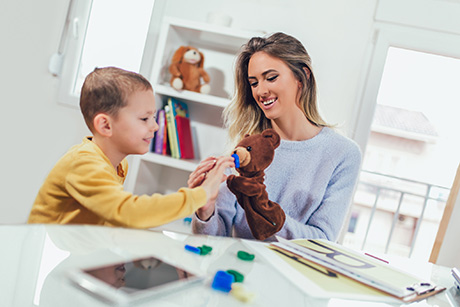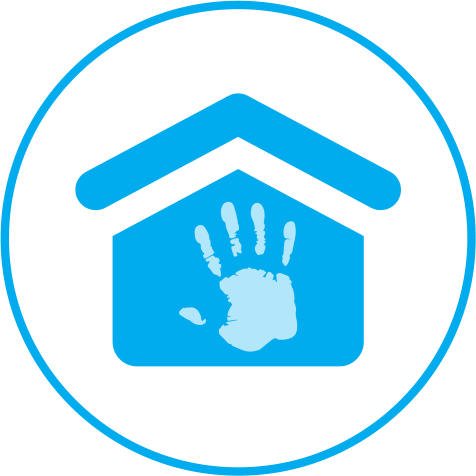Getting Comfortable: The Initial Sessions of Home-Based Behavioral Treatment
Your child or another family member has been diagnosed with autism spectrum disorder (ASD) or a similar developmental challenge and is about to begin home-based behavioral treatment based on the principles of applied behavior analysis (ABA). Initiating this type of intensive behavior intervention is a great step forward, and everyone in the family has the potential to benefit.
Intensive behavior intervention is the most widely accepted approach to assess and intervene with people who have developmental disabilities. With treatment, problem behaviors and their triggers can be understood and addressed. At the same time, new skills can be taught to help the individual function more effectively in everyday situations.
Starting home-based behavioral treatment may feel a little intimidating. You may be wondering what it will be like or what to expect as treatment begins. Sessions are scheduled based on the number of hours recommended in the treatment plan, as well as family preference and availability. Your clinical team will guide you every step of the way and will work with you and your family to help you adjust to the new expectations of ABA services.
The initial sessions will focus on building “rapport” between the individual receiving the services and the interventionist. Rapport refers to cultivating a relationship based on trust and on developing a connection with the client and family. It’s about establishing a comfort level and simply getting to know each other.
Building rapport is critical to set up the treatment for success, as it establishes an environment where the interventionist is paired with “fun” and “access” to preferred items and activities rather than on requests or “demands” to complete specific behavior-modifying tasks. The amount of time it takes to build rapport varies depending on the situation, the individuals involved and other factors including the number of sessions conducted each week.
The Steps to Building Rapport
How does the interventionist work to build rapport? It happens in a very purposeful way:
- First, ABA services are often initiated in the home because it’s the most familiar place and the most comfortable environment for the individual receiving services. Depending on the goal of the services, sessions may occur in other settings such as in a clinic, in the community or at school.
- Second, the interventionist works to get to know the individual slowly, recognizing there may be some fear or anxiety about having someone new or unknown in the family environment. Initially the interventionist may appear to be just hanging out in the same room as the client or watching the client engage in activities – such as general play, watching TV, or engaging with cell phone games – from across the room.During the first few sessions, the interventionist seeks to determine the client’s preferred items (his or her “stuff”) — be it toys, games, entertainment or other objects — and preferred activities, such as drawing or building things. A lot of observation occurs during this phase.Direct interactions with the client increase gradually. For example, the interventionist may start by watching the client play with their cars from 10 feet away, perhaps while sitting on the couch. Then they may move closer, say three to five feet away, and make comments or car sounds such as “VROOMMMM, BEEP BEEP, Crash them together!” to engage the client. Next, the interventionist might ask if they can play with a car, too. Each step is carefully navigated based on the client’s response to the prior step, with the interventionist making adjustments as needed to accommodate the client.
- Third, parents or other caregivers are always around during the sessions, either present and participating or acting as observers.The interventionist may request that a caregiver or other family members be involved in activities during session. If the client loves to play bubbles with dad, as an example, the interventionist will “pair” with dad and bubbles. If the client likes to go outside to race his brother on a slide in the backyard, the interventionist will join this activity. The interventionist also will ask about activities and interactions the client doesn’t like, so these can be known and avoided, at least initially, and about boundaries, including off-limit areas or activities at home.
After rapport has been established, there usually is a sense of trust and fun between the interventionist and the client. This means there’s a greater likelihood that as client goals are introduced, the client will want to participate and work together with the interventionist to achieve the goals of treatment, even when challenging. Over time, many clients come to view their interventionist as a coach — a helpful authority figure — and look forward to the sessions.
To learn more about our ABA-based services or how they may help someone in your family, please visit Applied Behavior Analysis (ABA). Or visit our Request a Consultation page to schedule a complimentary 30-minute phone or in-person consultation.
About the Author
Tasha Enriquez is a Board-Certified Behavior Analyst (BCBA) who has provided applied behavior analysis (ABA)-based treatment to children and adults with developmental disabilities since 2008. Tasha’s interest in behavior analysis started following volunteer work at a ranch where children and adults with developmental disabilities were taught to ride horses.
Tasha currently serves as the training manager for 360 Behavioral Health University, where she develops and provides training for new staff and current staff on topics in behavior analysis and clinical case management. Tasha is also a clinical supervisor for California Psychcare, where she provides direct supervision services for her clients and mentors trainees who aspire to be BCBAs.
Aside from her love of behavior analysis, Tasha also has 5 horses and enjoys spending time with her family.
Training Manager | Clinical Supervisor
360 Behavioral Health | California Psychcare
Applied Behavior Analysis, or ABA, refers to a variety of treatment options that are based on the principles of behavior analysis. ABA uses scientifically-based techniques for understanding and changing behavior, and is the most widely accepted approach to assess and intervene with individuals with autism spectrum disorder (ASD) or other developmental challenges or delays. This type of therapy is conducted one-on-one, is customized for each person, and is appropriate for individuals of all ages.



